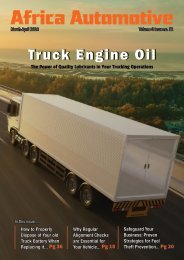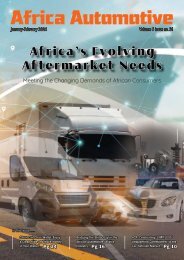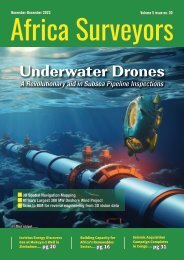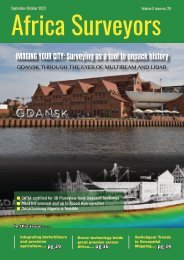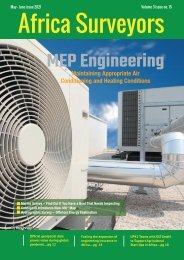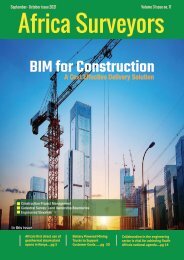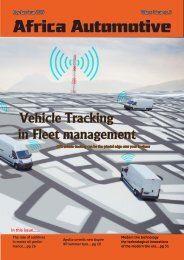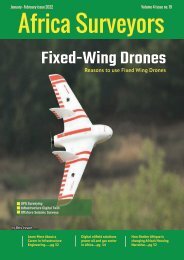Africa Surveyors November-December 2022 digital issue
Africa Surveyors is Africa’s premier source of Surveying, Mapping and Geospatial news and an envoy of surveying products/service for the Construction, Maritime, Onshore & Offshore energy and exploration, Engineering, Oil and Gas, Agricultural and Mining sectors on new solution based trends and technology for the African market.
Africa Surveyors is Africa’s premier source of Surveying, Mapping and Geospatial news and an envoy of surveying products/service for the Construction, Maritime, Onshore & Offshore energy and exploration, Engineering, Oil and Gas, Agricultural and Mining sectors on new solution based trends and technology for the African market.
You also want an ePaper? Increase the reach of your titles
YUMPU automatically turns print PDFs into web optimized ePapers that Google loves.
GEOSPATIAL
An aerial view of long horns cows in Central Equatoria, Terekeka, South Sudan. Geospatial technology, such as drones, can help generate critical scientific data to
support evidence-based decision making. (AFP/Eric Lafforgue/Hans Lucas)
as deforestation and human encroachment.
“One of the main challenges emerging
amongst forestry institutions is the lack of
updated data, which calls for efforts to update
that which already exists. At OFESA we are
addressing these capacity gaps as well as
supporting the development of a governance
framework for data sharing,” says Douglas
Bwire, a research officer at CIFOR.
Data collected under OFESA will be shared
with governments and organisations
protecting forests, through regular state of
forests reports. This was in acknowledgement
of the fact that without accurate data,
monitoring the ecological, environmental
and social aspects of wooded areas for
conservation is not possible, Bwire admits.
An even bigger initiative is Digital Earth
Africa (DE Africa). “DE Africa is empowering
countries across Africa with Earth
observations to enable climate adaptation
and mitigation, greater food security, and
sustainable development,” Kenneth Mubea,
DE Africa’s capacity development lead tells
Equal Times. Anyone, both in the private or
public sector or civil society, can use the data
generated, as long as it is for development
purposes.
Its partners include the Nigeria-based African
Region Institute for Geospatial Information
Science and Technology (AFRIGIST), the
Agriculture, Hydrology, Meteorology
(AGRHYMET) research centre based in Niger,
the Sahara and Sahel Observatory (OSS)
based in Tunisia, and the RCMRD, amongst
other regional bodies.
“We have created a huge impact, and stories
by end users are abound. For example, we
have supported the mapping mangroves
initiative [in Zanzibar, Tanzania], the
relocation of giraffes from a lake-flooded
island in Lake Baringo, Kenya, and we are
offering free training,” Mubea explains.
The platform offers online training to help
users explore and visualise available datasets.
This includes weekly sessions hosted in
English and French where users are guided
on the various uses and applications of Earth
observation in their daily work.
A driver for development
The conference also highlighted some of the
issues facing the widescale deployment of
geospatial technologies in Africa. One is low
investment. As well as a lack of familiarity
with such technologies by those who hold
the purse strings in government, there is
also the issue of scarce resources and a lack
of capacity to maintain and grow the use of
these technologies.
A 2019 report by the Africa Regional Data
Cube (ARDC), a project on satellite imagery
and Earth observation data in five African
countries , gives a good sense of some of
these challenges. For example, the report
notes that it takes “4-6 months of discussions
with stakeholders to establish an institutional
framework and buy-in from key stakeholders
to invest time and staff resources to adopting
the ARDC”. But many other organisations and
initiatives do not have the time or resources
to dedicate to this consistent level of
engagement and lobbying.
It also noted that, a significant amount of
time needs to be invested in “getting users
comfortable with the technology, so they fully
understand what it is, what information it can
provide, and how to access and use it”.
Another issue that can hamper the
widespread use of geospatial technologies
in Africa is the absence of regulations. One
of the victims of this is Fahari Aviation, a
subsidiary of Kenya Airways. While its drones
were widely deployed in aerial mapping,
agriculture, land survey, transport and
aviation, the company found it difficult to
expand beyond the Kenyan borders, owing to
a lack of regulation in member countries of
the East African Community (EAC), of which
Kenya is a founder member. This is despite
the fact that the company has partnered with
global aerospace giant Boeing to introduce
UAVs for aircraft inspection and maintenance.
“As we are all aware, data accuracy is a
major issue across Africa and an obstacle
to planning. This can be easily remedied by
deploying Earth observation science. From
experience we know that drone technology
allows for unmatched accuracy,” says Fahari
Aviation general manager Hawkins Musili.
However, until better regulation and more
money is put into the sector, its benefits will
remain limited on the continent.
www.africasurveyorsonline.com
November-December issue l 2022 37





